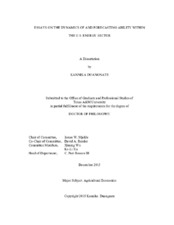| dc.description.abstract | Advances in production technology are increasing the availability of natural gas in the
U.S. Examining how these technological advancements influence the dynamics in the natural gas and energy sectors is the subject here. Tests for parameters constancy in cointegrated vector autoregressive models are applied to investigate the possible existence of structural changes in pricing relationships among North America natural gas spot markets. Results suggest that long-run pricing relationships among eight natural gas spot prices are not constant over the period of 1994 to 2014. Two potential breaks are found, during 2000 and 2009. Possible contributing factors to structural changes occurring during 2000 are expensive and volatile natural gas prices, the U.S. Federal Energy Regulatory Commission Order No. 637, and changes in imports. The major contributing factor to the structural change during 2009 is likely the shale gas revolution.
Prequential analysis is applied to determine how the presence of these structural breaks affects probabilistic forecasts of out-of-sample data of natural gas returns. Models using longer periods as the based estimation period, forecast returns better. Threshold cointegration examines the effects of the structural breaks on transaction costs between natural gas markets. Pairwise transaction costs differ between the 2009 preand post-break periods. During the post-break period, five of seven pairwise transaction costs decrease, while the remaining two pair-wise transaction costs increase relative to the pre-break period. Alterations in natural gas flows as the result of the shale gas revolution partially explain the transaction costs changes.
Finally, a data-rich methodology is used to investigate how the number of factors derived from a large number of time series influences inferences and probabilistic forecasting performance concerning natural gas production. Factor-augmented vector autoregressive models and prequential analysis are applied to data series of the U.S. energy and macroeconomic variables. The number of factors minimally affects inferences from factor-augmented vector autoregressive models, but considerably affects probabilistic forecasting performance. Exploiting estimated factor improves the forecasting ability, but including too many factors tends to exacerbate probabilistic forecasts performance. | en |


